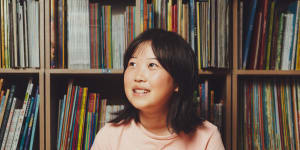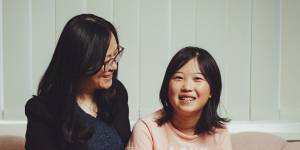Demand for places in NSW’s top-performing public selective schools swelled to a record high this year,with almost 17,200 students vying for just 4250 places.
But new figures reveal girls are still less likely than boys to apply for the high-stakes selective test,while the proportion of female students accepting a place has fallen to 42 per cent,its lowest since 2018.

Student Bonnie Li opted to turn down a place in a selective school for next year and will instead accept a scholarship at a private school.Dion Georgopoulos
Education experts say the reasons girls choose to reject an offer are complex,but can be due to family preferences,entrenched gender imbalances across the system,long commutes to selective schools outside their local area,and rising competition from the private system.
A wide-ranging review of access to the state’s 51 selective schools released six years ago said the NSW Department of Education would remedy system-wide problems and tackle after finding there were fewer places for girls,and they were more likely to turn down a spot.
followed with less emphasis on maths and more on writing and reading,while the department also boosted publicity for the test on social media and newsletters.
The changes also aimed to make the exam more difficult and less coachable after concerns parents were forking out to prepare their child for the exam.
But reforms have failed to lift applications from girls,with female students making up 46 per cent of total applicants for next year,down from about 47.6 per cent the year the review was released. Last year about 42 per cent of girls accepted offers (roughly 1770 students),falling from 45 per cent of girls accepting a place in 2019.
“There is this existing gender imbalance,with more boys enrolled at some selective schools,which may influence girls accepting a place,” said Jae Jung,a UNSW researcher in gifted education. “There is also a possibility that girls have a lower preference for selective schools in comparison to local comprehensive schools,private schools and Catholic schools.”
was also rolled out last year that sets aside 20 per cent of places at selective schools for disadvantaged students.
Data obtained by theHerald shows 394 initial offers were made to students under the equity model for next year’s entry,up about seven per cent compared with the 2023 intake. But just 25 Indigenous students received a first-round offer,down from 28 last year. Six students from a rural background were offered a place,91 students with a disability,and 272 from low socio-educational backgrounds.

Girls are more likely to turn down a place at one of NSW’s 51 selective schools after receiving the offer.Dion Georgopoulos
Australian Tutoring Association chief executive Mohan Dhall said recent changes,including adding a ‘thinking skills’ component to the test and reserving places under the equity model,had intensified competition.
He said major tutoring centres often had more boys enrolled for coaching,while he believes families with girls may steer away from selective schools if “they feel that level of competition is not what parents think is healthy for them”.
But the data also shows that the overall offers to girls has increased in the past six years from about 42 to 44 per cent.
“We have increased the information available to parents and students,addressing common myths and misconceptions,” a NSW Education Department spokesperson said.
“We are continuing to analyse entry data as well as the reasons girls are less likely to apply and more likely to decline a place in a selective high school.”
Last month,the department released its first round of 4240 offers for next year with about 1790 offers going to girls,down from about 1840 last year.
Bonnie Li,an artistic and book-loving year 6 student from the city’s north-west,took the test in May and was offered a place in a selective high school when first-round offers were released last month.
Li,who hopes to study biology or zoology after finishing year 12,said she decided to turn down the offer,instead taking up a scholarship at an all-girls private school.
“Selective schools are good at academics,but I don’t think students focus as much on other activities. I want to be able to spend lots of time doing sport,drawing and art. I love reading,playing badminton and swimming. I want to have a challenging experience at school,and I also want to meet new friends,” she said.
Her mother,Flora Xie,worried that taking the selective school route would mean Bonnie would need to spend significant time and effort staying on top of academic demands.
“Academics are so important,but I hope she can explore other areas. I was also concerned about how much pressure both of us would be under to make sure she was staying ahead in such a competitive environment,” she said.
Melinda Gindy,president of the Australian Association for the Education of the Gifted and Talented (AAEGT),said more research was needed to understand why selective schools have a gender imbalance.
“Girls may be more inclined to want to go to schools with their peer groups from primary school,” she said.
“We need to understand if girls are underperforming compared with their male counterparts in the test and what other factors are at play,such as being influenced by social groups. We should be surveying year 5 and 6 students to understand what their perceptions are if they are planning to sit the test.”
Associate Professor Christina Ho,from the University of Technology Sydney,said with the model of external tutoring that is common in NSW,students are accelerated so that they are covering materials sometimes a year ahead of the school curriculum.
“This acceleration is easier to do for maths than for many other subjects. At the same time,there is a gender bias in our society where maths is more appealing to boys than to girls,” she said.
“The large and expanding role played by the tutoring industry could help to explain the gender gap in selective school offers.”
Start the day with a summary of the day’s most important and interesting stories,analysis and insights..